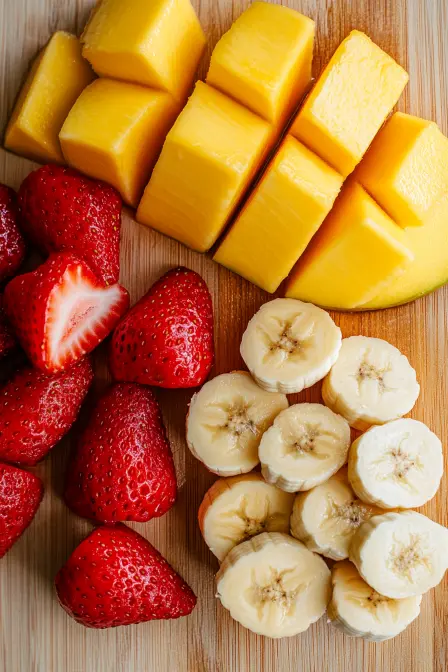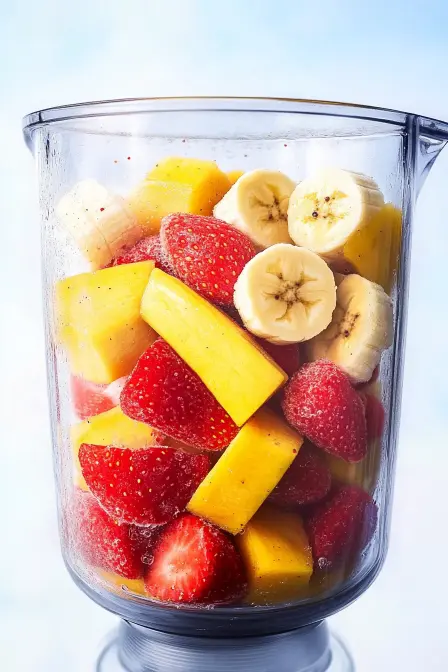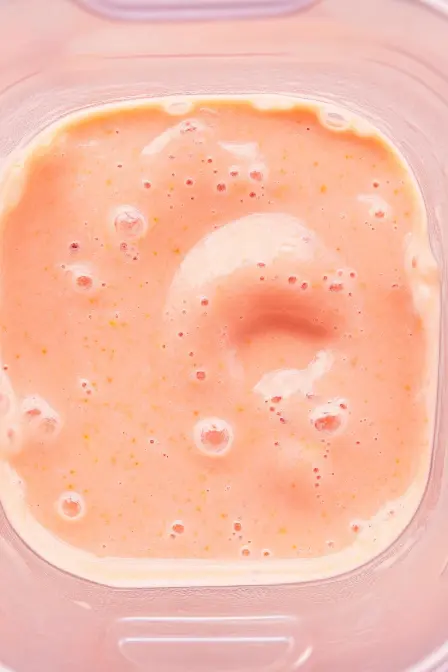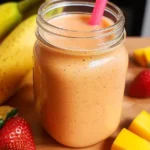A strawberry mango banana smoothie is one of the most delicious and nutritious ways to kick-start your day. This vibrant blend of tropical fruits delivers a naturally sweet flavor, creamy texture, and a blast of essential nutrients all in one glass. If you’re searching for a smoothie that tastes like summer while packing in fiber, vitamins, and antioxidants, this fruity combo is exactly what you need.
In this guide, we’ll cover everything you need to know about making the perfect strawberry mango banana smoothie. You’ll learn about its impressive health benefits, ingredient breakdowns, blending tips, flavorful variations, storage hacks, and more. Plus, we’ll clear up popular questions like “Do mango, banana, and strawberry go together?” and “Are strawberry banana smoothies healthy?”
Check out Panera strawberry banana smoothie for a café-style twist on your favorite fruity blend.
Nutritional Benefits of Strawberry Mango Banana Smoothie

Health Perks of Mango, Banana, and Strawberry
A strawberry mango banana smoothie isn’t just a tasty treat—it’s loaded with powerful nutrients that support your overall well-being. Each fruit contributes something unique to this blend:
- Strawberries are rich in vitamin C, manganese, folate, and antioxidants like anthocyanins. They help boost immunity, reduce inflammation, and improve heart health.
- Mangoes offer a sweet punch of vitamin A, vitamin C, and potassium. They’re high in polyphenols, which have been linked to better eye health and digestion.
- Bananas are a great source of potassium, vitamin B6, and fiber. They provide long-lasting energy, support digestive health, and help regulate blood sugar levels.
When combined in a smoothie, these fruits offer a wide range of health benefits while keeping the sugar content natural and energy levels high.
| Nutrient | Strawberries (1 cup) | Mango (1 cup) | Banana (1 medium) |
|---|---|---|---|
| Calories | 49 | 99 | 105 |
| Vitamin C | 89.4 mg | 60.1 mg | 10.3 mg |
| Potassium | 233 mg | 277 mg | 422 mg |
| Fiber | 3 g | 2.6 g | 3.1 g |
| Sugar (natural) | 7.4 g | 22.5 g | 14.4 g |
Vitamins, Fiber, and Antioxidants in Each Fruit
What makes the strawberry mango banana smoothie stand out nutritionally is its blend of essential vitamins and antioxidants that serve multiple body functions:
- Vitamin C supports skin health, collagen production, and immune function. Both mangoes and strawberries are excellent sources.
- Fiber keeps your digestive system regular and may help lower cholesterol levels. This smoothie delivers over 8g of fiber per serving when made with whole fruits.
- Antioxidants found in all three fruits help fight oxidative stress, which is linked to aging and chronic diseases.
Whether you’re trying to improve digestion, fight fatigue, or just stay refreshed, this smoothie delivers an impressive nutrient profile in every sip.
Why Mango, Banana, and Strawberry Make a Perfect Combo
Do Mango, Banana, and Strawberry Go Together?
When it comes to crafting the ideal smoothie, not every fruit combo delivers balance. But the strawberry mango banana smoothie hits all the right notes. These three fruits are not only compatible in flavor—they’re practically made for each other.
- Mango adds a juicy, tropical sweetness and creamy texture.
- Banana brings a soft, thick consistency with a subtle mellow flavor.
- Strawberries cut through with a tart brightness that balances everything beautifully.
Together, they create a well-rounded flavor profile that’s rich, refreshing, and naturally sweet. No added sugar required. Whether you’re making a post-workout drink, a morning refresher, or a healthy dessert, this fruity trio is a smart and satisfying choice.
That’s why the strawberry mango banana smoothie has become a top pick for smoothie lovers and health enthusiasts alike. It’s not just about taste—it’s about how well the flavors and textures work together in one silky sip.
Flavor Profile Breakdown: Sweet, Tart, and Creamy Balance
Each fruit in a strawberry mango banana smoothie plays a crucial role in both taste and texture. Here’s a quick breakdown:
| Fruit | Flavor Role | Texture Role |
|---|---|---|
| Mango | Sweet, tropical notes | Juicy and smooth |
| Banana | Mild sweetness | Thick and creamy |
| Strawberry | Bright and tart | Light and slightly juicy |
Adjusting the ratio of fruits lets you fine-tune your smoothie:
- More mango? You’ll boost the sweetness and tropical vibe.
- Extra banana? Expect a creamier and thicker drink.
- Add strawberries for a tangy kick and refreshing lift.
For a next-level flavor experience, freeze your fruits ahead of time. It chills the drink without watering it down.
Discover great ideas like strawberry pineapple banana smoothie if you enjoy a tropical zing in your smoothie.
Essential Ingredients for the Perfect Smoothie

Fresh vs Frozen Fruits: What Works Best?
When making a strawberry mango banana smoothie, one of the most common questions is whether to use fresh or frozen fruits. The answer? It depends on your texture preference and time.
Frozen fruits offer several benefits:
- They make your smoothie thicker and colder without needing ice.
- They’re often picked and frozen at peak ripeness, locking in nutrients.
- They last longer, which is perfect for meal prepping.
Fresh fruits, on the other hand:
- Provide a lighter, more natural texture.
- Are great when they’re in season and full of flavor.
- Blend more quickly, reducing wear on your blender.
Best tip: Use frozen mango and banana with fresh strawberries for the ideal creamy-tangy balance.
This blend gives the strawberry mango banana smoothie a frosty texture and vibrant color without watering it down.
| Fruit | Recommended Form | Why |
|---|---|---|
| Mango | Frozen | Adds thickness and a cold tropical touch |
| Banana | Frozen | Creamy base, no need for ice |
| Strawberry | Fresh or Frozen | Use fresh for brightness, frozen for chill |
Liquid Base Options: Almond Milk, Yogurt, or Juice?
The liquid base you choose will dramatically impact both the flavor and nutrition of your strawberry mango banana smoothie. Let’s look at the best options:
- Almond milk – Low in calories and perfect for a dairy-free version. Adds a light nutty flavor that pairs well with all three fruits.
- Greek yogurt – Great for extra protein and creaminess. Ideal if you’re making your smoothie a meal.
- Coconut water – A hydrating, tropical choice that keeps the smoothie light and refreshing.
- Orange juice – Adds tangy sweetness and a vitamin C boost but increases sugar levels.
For a balanced, everyday version of the strawberry mango banana smoothie, unsweetened almond milk or low-fat Greek yogurt are ideal. They allow the natural fruit flavors to shine without overpowering sweetness.
How to Make the Best Strawberry Mango Banana Smoothie
Step-by-Step Recipe Guide with Prep Time
Making a strawberry mango banana smoothie is quick, easy, and practically foolproof. All you need is a good blender, quality ingredients, and a few minutes. Here’s a simple, no-fuss recipe anyone can follow:
Ingredients:
- 1 cup frozen mango chunks
- 1 ripe banana (frozen or fresh)
- 1 cup fresh or frozen strawberries (hulled)
- 1 cup almond milk (or any preferred liquid)
- Optional: ½ cup Greek yogurt for protein
- Optional: 1 tablespoon chia seeds or honey
Instructions:
- Add the liquid base (almond milk or juice) to the blender first.
- Add the fruits—start with banana, then mango, then strawberries.
- If you’re using yogurt, seeds, or honey, toss them in next.
- Blend on high for 30–60 seconds until smooth and creamy.
- Taste test—adjust sweetness or consistency as needed.
Prep Time:
- 5 minutes total (including slicing if needed)
This recipe makes 1–2 servings, perfect for a healthy breakfast or post-workout snack.
Pro Tip: For an extra thick strawberry mango banana smoothie, use all frozen fruit and a splash less liquid. It’ll be creamy and spoonable—almost like soft serve.
Best Blender Techniques for a Creamy Texture

Even the best ingredients won’t matter if you don’t blend them right. A smooth, lump-free strawberry mango banana smoothie relies on good technique.
Follow these blending tips:
- Layer strategically: Liquid first, then soft fruits, then frozen items. This reduces air pockets and ensures a faster blend.
- Pulse first: Start on low or pulse a few times before going full power.
- Use a tamper: If your blender has one, use it to press thick mixtures down toward the blades.
- Scrape sides: Stop halfway and scrape down the sides to get everything evenly mixed.
If you’re using a high-powered blender like a Vitamix or Ninja, 30 seconds is enough for a silky-smooth result. For standard blenders, blend a little longer and add liquid in small amounts until the smoothie reaches your ideal consistency.
Variations and Add-Ins to Try
Adding Protein, Greens, or Seeds
One of the best things about a strawberry mango banana smoothie is how easy it is to customize for your nutritional goals. Whether you want to boost your protein intake, sneak in some greens, or add extra fiber, here are the best add-ins to consider:
Protein Boosters:
- Greek yogurt – Adds creaminess and 10–15g of protein.
- Protein powder – Choose plant-based or whey depending on your dietary needs.
- Nut butters – Almond or peanut butter give richness and healthy fats.
Greens & Veggies:
- Spinach – Blends well and is rich in iron, fiber, and antioxidants.
- Kale – Adds a stronger green flavor, best when paired with ripe banana.
- Cauliflower (frozen) – Mild taste, adds creaminess without changing flavor.
Super Seeds:
- Chia seeds – Excellent for fiber and omega-3s.
- Flaxseeds – Good for digestion and heart health.
- Hemp seeds – Soft texture, high protein, nutty taste.
These nutrient-rich extras make your strawberry mango banana smoothie even more functional—turning a simple snack into a complete mini-meal.
Dairy-Free and Vegan-Friendly Options
Going dairy-free or vegan? No problem. This smoothie is easy to adjust without compromising on taste or texture.
Here’s how to keep your strawberry mango banana smoothie plant-based:
- Swap out Greek yogurt for coconut yogurt or almond-based yogurt.
- Use almond milk, coconut milk, or oat milk as your liquid base.
- Add a scoop of plant-based protein powder like pea, hemp, or brown rice.
For added flavor:
- Try a pinch of cinnamon or vanilla extract.
- Add dates or a teaspoon of maple syrup if you want extra natural sweetness.
These small changes allow you to align the smoothie with your dietary preferences while still enjoying the sweet, creamy benefits of the original blend.
Looking for inspiration? Try strawberry banana apple smoothie for a crisp, fiber-rich variation of the classic blend.
Health and Fitness Benefits of This Smoothie
Are Strawberry Banana Smoothies Healthy?
Absolutely. A well-balanced strawberry mango banana smoothie delivers a nutritional punch in every sip. When made with whole fruits and minimal additives, it becomes a low-fat, fiber-rich, vitamin-loaded drink that can fuel your body and mind.
Here’s what makes it a healthy option:
- Low in processed sugars: All sweetness comes from natural fruit.
- Rich in fiber: Helps with digestion, gut health, and keeps you full longer.
- Loaded with vitamins: Strawberries and mangoes provide vitamin C, bananas add potassium and B6.
- Antioxidant powerhouse: Fights inflammation and supports immune health.
Compared to sugary store-bought drinks, this homemade strawberry mango banana smoothie is a clean, nutrient-dense option that fits most dietary plans.
Whether you’re watching your weight, boosting immunity, or just trying to eat cleaner, this smoothie delivers nutrients without the junk.
| Nutritional Highlight | Benefit |
|---|---|
| Vitamin C | Boosts immune system & collagen production |
| Potassium | Regulates fluid balance & heart function |
| Fiber | Aids digestion & helps you feel full longer |
| Antioxidants | Reduce inflammation & protect cell health |
Ideal Time to Drink for Energy and Recovery
Timing matters when it comes to nutrition—and the strawberry mango banana smoothie fits perfectly into multiple moments in your day:
Morning Kickstart:
Start your day right. The natural sugars and fiber give you a clean energy boost without a crash.
Post-Workout Recovery:
This smoothie is rich in potassium (from bananas) and vitamin C (from strawberries and mangoes), which support muscle recovery and reduce soreness. Add some protein, and it becomes an excellent post-gym refuel.
Afternoon Slump Fix:
Skip the coffee and blend a smoothie instead. It refreshes, rehydrates, and curbs snack cravings.
Late-Night Snack:
Craving something sweet at night? A smaller portion of this smoothie satisfies your sweet tooth without ruining your sleep or spiking your blood sugar.
Common Mistakes to Avoid
Over-Blending or Under-Blending Issues
Blending a strawberry mango banana smoothie may sound foolproof, but it’s surprisingly easy to go wrong. One of the biggest culprits? Not blending it just right.
Over-blending:
- Turns your smoothie into a thin, foamy mess.
- Can heat up the mixture, dulling flavor and nutrients.
- Causes separation if left to sit too long.
Under-blending:
- Leaves unpleasant chunks of fruit or seeds.
- Results in uneven texture and poor consistency.
How to avoid it:
- Blend in stages. Start on low speed to combine, then switch to high for a smooth finish.
- Use a tamper or pause and stir to keep ingredients moving.
- Stop as soon as the smoothie looks thick, glossy, and uniform.
A perfectly blended strawberry mango banana smoothie should pour thick but flow easily—like drinkable velvet.
Wrong Fruit Ratios and Their Impact
Getting the fruit balance right is key to flavor and texture. Too much of any one fruit can throw off the smoothie’s harmony.
Too much banana?
- Overpowers flavor with a mushy sweetness.
- Makes the smoothie too thick.
Too much mango?
- Can make the smoothie overly sweet or sticky.
- May need extra liquid to blend well.
Too many strawberries?
- Leads to a tart, slightly watery taste.
- Can dominate the color and mask the mango’s sweetness.
Ideal Ratio:
- ½ banana
- 1 cup mango chunks
- ¾ cup strawberries
- 1 cup liquid base
This balance keeps your strawberry mango banana smoothie refreshing, smooth, and layered in taste. Always taste-test before serving—you can tweak the mix to your liking.
Best Times and Occasions to Enjoy This Smoothie
Breakfast Boost or Post-Workout Refreshment?
A strawberry mango banana smoothie fits seamlessly into many moments of your day—but two of the most powerful times to drink it are in the morning and after a workout.
As a breakfast smoothie, it’s:
- Light on the stomach yet filling enough to keep hunger away for hours.
- Packed with vitamins, fiber, and natural sugars to give you that early energy boost.
- Easy to digest, making it ideal if you’re in a rush or not a heavy breakfast eater.
Post-workout, it becomes:
- A fast way to replenish lost nutrients like potassium and magnesium.
- Great for reducing muscle fatigue when paired with Greek yogurt or a scoop of protein powder.
- A cooling, hydrating reward after a tough gym session.
Blend it with a bit of coconut water or plant-based protein to transform your regular strawberry mango banana smoothie into a recovery hero.
Serving Ideas for Kids and Guests
This smoothie isn’t just for health nuts—it’s a family-friendly, party-worthy drink too. If you’re serving it to kids or guests, make it extra fun and visually appealing:
For kids:
- Serve in mason jars with reusable straws.
- Top with a swirl of yogurt and a sprinkle of granola.
- Pour into popsicle molds to make smoothie pops.
For guests:
- Add a decorative fruit skewer (strawberry, banana slice, mango cube).
- Serve chilled in cocktail glasses for a bright, tropical mocktail.
- Offer a smoothie bar setup: Let guests customize with toppings or mix-ins.
These ideas turn a regular strawberry mango banana smoothie into something festive, interactive, and Instagram-worthy—no alcohol needed.
Don’t miss our strawberry banana peach smoothie for a refreshing summer treat that’s perfect for parties or brunch.
Storage, Shelf Life & Meal Prep Tips
Can You Freeze the Smoothie for Later?
Yes, and it’s one of the easiest ways to keep your strawberry mango banana smoothie ready for whenever you need it. Whether you’re meal-prepping for the week or saving leftovers, freezing is a smart move.
How to freeze properly:
- Portion your smoothie into airtight containers or mason jars.
- Leave a little space at the top to allow for expansion.
- You can also pour the smoothie into silicone ice cube trays and store the cubes in a freezer bag—perfect for fast blending later.
Reheating isn’t necessary—just thaw it in the fridge for a few hours or blend the frozen cubes with a splash of liquid to refresh the texture.
Your smoothie will still taste great and retain most of its nutrients after freezing. It’s the perfect trick to avoid food waste and stay consistent with healthy habits.
Tips to Keep It Fresh and Tasty Over Time
If you prefer to keep your strawberry mango banana smoothie in the fridge instead of the freezer, here’s how to make sure it stays delicious:
Fridge Storage:
- Store in a tightly sealed glass container.
- Keep it chilled at all times—don’t leave it out for more than 30 minutes.
- Consume within 24 to 48 hours for best taste and texture.
Prevent separation:
- Shake or stir before drinking—it’s natural for ingredients to settle.
- Use a bit of lemon juice to slow oxidation and keep the color bright.
Meal Prep Tip:
- Prep your smoothie ingredients in freezer-safe bags—just fruits and extras, no liquid.
- When ready to drink, toss the contents into a blender, add your liquid base, and blend.
This keeps your strawberry mango banana smoothie routine fast, fresh, and stress-free—perfect for busy mornings, gym sessions, or school runs.
Frequently Asked Questions
Do mango, banana, and strawberry go together?
Yes, they absolutely do! Mango, banana, and strawberry create a perfectly balanced flavor profile. Mango offers tropical sweetness, banana adds creaminess and a smooth texture, and strawberries bring a touch of tartness. Combined, they form a naturally sweet, refreshing base that makes the strawberry mango banana smoothie one of the most flavorful blends you can make.
Is it okay to mix mango and banana together?
Definitely. Mango and banana are a fantastic duo for smoothies. They both blend smoothly and create a rich, thick texture with no need for added thickeners. Plus, their flavors complement each other—banana mellows the mango’s intense sweetness, resulting in a smooth, balanced drink, especially when paired with strawberries in a strawberry mango banana smoothie.
Do strawberry and mango go well in a smoothie?
Yes, strawberries and mango go exceptionally well in smoothies. Their sweet and tart contrast adds depth and brightness to your drink. Together, they’re especially refreshing and are often paired with banana to round out the texture and taste—making the strawberry mango banana smoothie a go-to recipe in many kitchens.
Are strawberry banana smoothies healthy?
Absolutely. A well-made strawberry banana smoothie is packed with vitamins, antioxidants, fiber, and natural energy-boosting sugars. When combined with mango and a clean liquid base like almond milk or yogurt, the result is a nutrient-dense strawberry mango banana smoothie that supports digestion, immune health, and energy levels—all without processed ingredients.
5 Powerful Reasons to Drink a Strawberry Mango Banana Smoothie
It’s Deliciously Satisfying
The tropical flavor combo of mango, banana, and strawberry is always a win.
It’s Packed with Natural Nutrients
You get vitamin C, potassium, fiber, and antioxidants—all from real fruit.
It’s Quick and Easy to Make
Just blend three simple ingredients in under five minutes.
It’s Versatile and Customizable
Add protein, greens, or seeds to match your health goals.
It’s Perfect for Any Time of Day
Morning, post-workout, or dessert—this smoothie fits all routines.
Explore more creative blends like avocado banana strawberry smoothie for a creamy, heart-healthy twist with healthy fats.
Conclusion
The strawberry mango banana smoothie isn’t just a delicious drink—it’s a vibrant, health-boosting powerhouse that fits into any lifestyle. Whether you’re starting your morning, recovering after a workout, or simply looking for a naturally sweet treat, this smoothie checks every box.
By blending the tropical richness of mango, the creamy comfort of banana, and the tangy freshness of strawberries, you get a perfectly balanced drink that’s as nutritious as it is flavorful. From customizing it with superfoods to prepping it for the week, this smoothie adapts to your taste, your goals, and your schedule.
Follow us on Facebook and explore our Pinterest at Sappy Recipes for daily smoothie tips, colorful strawberry mango banana smoothie ideas, and fruit-packed recipe inspiration.
Print
Strawberry Mango Banana Smoothie
- Total Time: 5 minutes
- Yield: 1–2 servings 1x
- Diet: Gluten Free
Description
Strawberry mango banana smoothie is a creamy, tropical blend made with real fruit, perfect for breakfast, post-workout, or a refreshing healthy snack.
Ingredients
1 cup frozen mango chunks
1 ripe banana (fresh or frozen)
1 cup strawberries (hulled, fresh or frozen)
1 cup almond milk (or your favorite liquid base)
Optional:
½ cup Greek yogurt (for creaminess + protein)
1 tbsp chia seeds or flaxseeds
1 tsp honey or maple syrup (for added sweetness)
Instructions
Add almond milk (or other base) to the blender first.
Add mango, banana, and strawberries.
Include Greek yogurt, seeds, or sweetener if desired.
Blend on high for 45–60 seconds until smooth and creamy.
Pour into a glass and enjoy immediately, or chill for later.
Notes
For a thicker smoothie, use all frozen fruit and reduce the liquid slightly.
To make it vegan, substitute Greek yogurt with coconut or almond-based yogurt.
Meal prep tip: Freeze chopped mango, banana, and strawberries in individual bags—just add liquid and blend when ready.
If you prefer a sweeter taste, add 1 pitted date or a splash of maple syrup.
Best enjoyed immediately, but can be stored in the fridge for up to 24 hours.
Try it with coconut water for a lighter, more hydrating variation.
- Prep Time: 5 minutes
- Cook Time: 0 minutes
- Category: Smoothies, Drinks, Breakfast
- Method: Blending
- Cuisine: American, Tropical-Inspired
Nutrition
- Calories: 180 kcal
- Sugar: 18 g (natural)
- Sodium: 60 mg
- Fat: 2.5 g
- Saturated Fat: 0.6 g
- Unsaturated Fat: 1.8 g
- Trans Fat: 0g
- Carbohydrates: 38g
- Fiber: 4g
- Protein: 3g
- Cholesterol: 0mg

